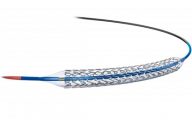Aortic stenosis shares risk factors with coronary artery disease (CAD), and its prevalence varies according to age, reaching approximately 50% or more in some registries. Deciding when to treat and the need for percutaneous intervention presents a challenge. It has been established that epicardial stenosis at proximal level, or the medial segment, requires intervention, especially…
Long-term Results of Coronary Bifurcation Lesion Treatment in Diabetic Patients
The effects of diabetes on patients with coronary artery disease are well-known, and their outcomes after angioplasty are less favorable, with a higher rate of restenosis, recurrent acute myocardial infarction, and stent thrombosis. Despite advances in drug-eluting stents and procedural techniques, the treatment of coronary bifurcation lesions in diabetic patients shows less positive clinical outcomes…
TCT 2023 | ISAR-DESIRE 3: 10-Year Results
In-stent restenosis (ISR) remains the primary limitation of percutaneous treatment for coronary artery disease. The strategy to address this limitation involves the use of drug-eluting stents (DES) or drug-coated balloons (DCB), both of which have proven to be effective and safe therapeutic alternatives. Despite current recommendations, treating ISR continues to be a challenge, and clinical…
EASTBOURNE Registry: Use of Sirolimus-Coated Balloons in Coronary Artery Disease
The introduction of drug coated balloons (DCB) has become an innovative therapeutic alternative to current treatments. Paclitaxel-coated balloons (PCB) have been used to treat in-stent restenosis (ISR) and also approach CAD in native arteries. More recently, sirolimus-coated balloons (SCB) are being looked at as part of pilot studies and smaller registries with preliminary results. The…
EuroCTO: Safety and Benefit at 3 Years
Chronic total occlusions (CTOs) account for approximately 15-20% of patients with stable coronary artery disease. This field has seen various advances regarding treatment, leading to an improvement in the success rate of procedures. According to registries and randomized studies, the main indication for percutaneous coronary intervention (PCI) of CTO should be based more on clinical…
Diffuse Coronary Artery Disease: One-Year 48mm XIENCE Skypoint Outcomes
Long 48mm Stent XIENCE Skypoint in the treatment of diffuse CAD Long coronary artery lesions often involve complex decision making since they can be treated either with a long stent or with shorter overlapping stents. Both in registries and meta-analysis, the overlapping technique has been associated to increased target vessel revascularization and increased radioscopy time,…
Clinical Impact of Coronary Artery Disease on Results After TAVR
Coronary artery disease (CAD) coexists with aortic stenosis in about half the patients who suffer the latter. These patients receiving antiplatelet therapy are at a higher risk of periprocedural bleeding—one of the most frequent complications in patients who undergo transcatheter aortic valve replacement (TAVR). One way of limiting the risk for bleeding is choosing the…
ACC 2023 | Subanalysis of the REVIVED-BICS Study2
This study demonstrated that coronary angioplasty does not entail any benefit in chronic stable angina over optimal medical therapy in those with impaired ventricular function (EF >35%) with extensive coronary artery disease and viable myocardium. Dr. Divaka Perera performed a subanalysis of said study. At the time of the study, the amount of viability and…
Biolimus and Everolimus Eluting Stents in Coronary Artery Disease: Similar Safety?
Courtesy of Dr. Guillermo Migliaro. Events such as very late stent thrombosis and restenosis after first generation DES stenting were associated to the inflammatory response of site implantation. The presence of a durable or permanent polymer was thought to play a central role in said inflammatory process, which caused, among other things, delayed re-endothelialization and…
Aspirin Desensitization in Patients with Coronary Artery Disease
There are limited data on aspirin desensitization in patients with coronary artery disease (CAD). The aim of this study was to test the safety and efficacy of a rapid desensitization protocol inpatients with a history of aspirin sensitivity about to receive PCI. This was a prospective multicenter observational study, carried out in seven Italian…
- 1
- 2









